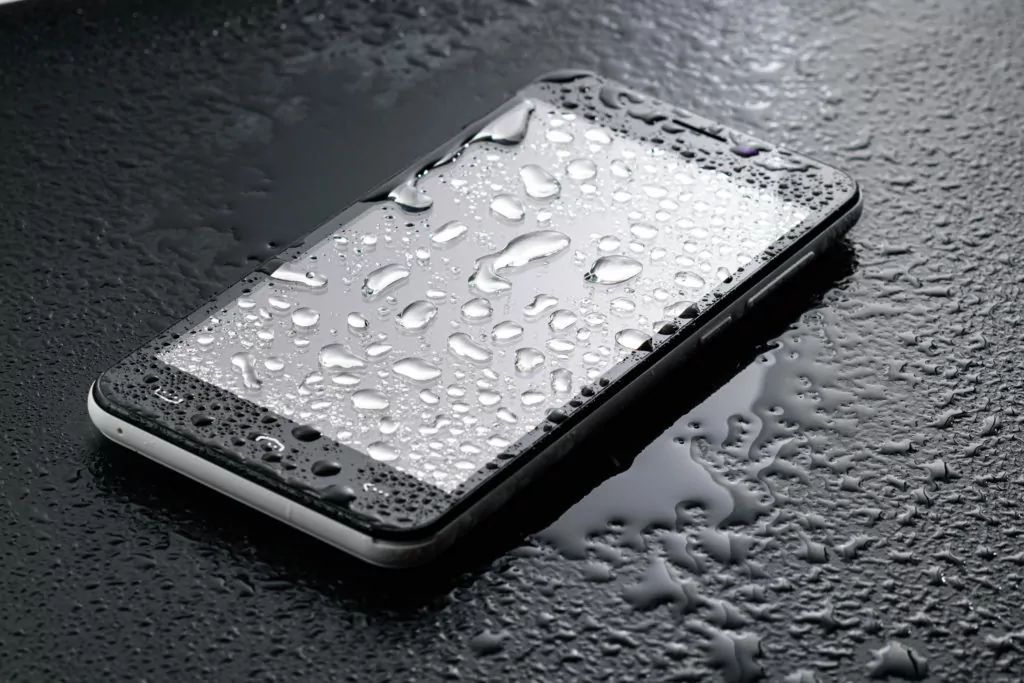Here’s everything about shower steam being potentially damaging to your phone:
Yes, steam can damage your phone.
Even if your phone is rated as waterproof or water-resistant, it is possible for steam to get past those protective layers and still cause damage.
Waterproof phones are at less risk from steam, but repeated steam exposure can shorten the life of any phone.
So if you want to learn all about how shower steam can damage your phone exactly, then this article is for you.
Let’s jump right in!
- MacBook Clamshell Mode Constantly: Safe?
- Dropping Phone: Affects Phone’s Performance?
- Storing Laptop Vertically: Bad?
- Laptop Brands With Most Durable Hinges: Which?
- Leaving Phone Flashlight On: Bad?
- Dropping Your Phone: What Happens?
- Microwaving Cell Phones: What Happens?

How Does Water Damage a Phone? (3 Things)

We all know that water is bad for electronics, but do you really know why?
How does water actually damage a phone?
You can jump in a swimming pool and be fine, so what is different about electronics?
You probably have an intuitive idea of the first problem.
Water can create shorts that directly damage circuits.
We’ll get into the specifics of how this happens in a moment, but shorts are why water can immediately destroy a phone in a worst-case scenario.
But, water can do more than just short out phones.
It can oxidize and even corrode them, and it’s important to understand each of these risks, as they are all present when steam gets inside of a phone.
#1 Conductivity

Contrary to popular belief, water is a poor conductor of electricity.
But, if water is very bad at conducting electricity, why is it bad to go swimming in a lightning storm?
This comes down to solubility.
Water is very good at dissolving things, and the things dissolved can be great conductors of electricity.
When water dissolves something that can move electricity easily, the dissolved conductor is called an electrolyte.
You’ve seen electrolytes advertised in sports drinks and other things.
That’s because your body’s nervous system works by sending electrical currents from one place to another via electrolytes dissolved in water.
So, when you have good electrolyte saturation in water, the combined solution conducts electricity very well.
What does this mean for your phone?
Well, if a conducting solution gets into the circuitry of the phone, it creates electrical pathways that aren’t supposed to be there.
The electricity can flow in the wrong direction and to vulnerable components.
This can cause the small circuitry in the phone to overheat and literally burn.
If you’ve ever seen an electrical device spark and/or start to smoke, you likely saw a short in the circuit cause this very problem.
Since water can get just about anywhere, it can cause dangerous shorts in the circuitry and quickly kill a phone.
This, by the way, is why the best way to treat a wet phone is to turn it off.
Don’t put it in rice or try any other “hacks” you saw on the internet.
Stop the flow of electricity.
If no electricity goes through the circuits while the system is wet, it can’t short.
If you run the phone while it is wet on the inside, the risk abounds.
#2 Oxidation

Another risk of water is oxidation.
This is completely different from conductivity.
Water is made from hydrogen and oxygen, and the oxygen in the water is very good at oxidizing things (it’s no coincidence that these two words sound so similar).
Oxidation is a chemical term that describes when one atom strips electrons away from another atom.
Oxidation chemically changes materials.
So, in terms of a precision-designed phone, oxidation is very likely to cause physical damage to the device.
It absolutely can completely destroy a device over time.
What makes steam scary is that oxidation can occur even if the water doesn’t have electrolytes.
When water evaporates (or becomes steam), most of the electrolytes are left behind.
Steam is very nearly pure water, so you’re not all that worried about shorts here.
It’s a bad conductor.
The bigger threat is oxidation.
The pure water of steam can oxidize components in the phone just fine, and that can still ultimately destroy your phone.
This is one of the main threats of steam exposure to a phone.
#3 Corrosion

Then there’s corrosion.
When a metal is oxidized, the result is called corrosion.
You’ve probably seen rusty metal before.
That’s corrosion.
When it comes to water and corrosion, things get a little complicated.
Some metals are easily oxidized by water, like iron and many forms of steel.
Other metals don’t corrode easily from water exposure.
Copper is a primary example, and that’s a good thing for your phone.
Many of the circuits in the phone are made out of copper.
The larger issue is that many acids can and do corrode copper.
This is the part that matters the most with steam.
Steam is pure water (for the most part), so it isn’t an acid. Still, it can get into your phone.
While pure, it can’t short out the phone, and it can’t corrode the copper.
Steam should be fine, right?
Unfortunately, it’s possible (and actually likely) that your phone’s insides have soluble substances somewhere.
These are metals, minerals, and other things that can get into the circuitry over time.
In many cases, these substances are left over from manufacturing.
The issue is that steam can get into the phone. Once there, it cools off and condenses.
It can then dissolve the residues already inside the phone.
Some of them are conductive and create shorts.
Others become acidic when dissolved in water.
Now, the steam is an agent of corrosion for the metals in your phone. In all of these ways, steam can end your phone.
How Does Steam Get Into a Phone?

Obviously, you need to keep steam out of your phone if it can cause all of these problems.
How do you do that?
It helps to know how steam gets in there in the first place.
With older phones, it’s easy to see how steam could find its way to the circuits.
Every phone has plugs and speakers, and in older models, those constitute deliberate holes in the phone’s casing and design.
Of course, steam could slip through these holes and get to the inner workings of the phone.
But, most modern phones are waterproof (at least to some degree).
That means that the speaker and charging holes don’t provide direct access to the inner circuitry.
So how does steam get into a waterproof design?
This comes down to the phone’s ingress protection rating and how that works.
An ingress protection rating follows an international standard where products are rigorously tested to see what kinds of things can get through the protective layer(s).
The tests include intense water jets, submersion in water, wind blasting sand, and all kinds of intense scenarios.
Ultimately, the stuff that makes it through the outer layers of protection is used to determine the ingress protection rating.
Most phones have a rating of IP67 or IP68.
With this code, the first number refers to solid particles.
The second number refers to water.
So, most phones are dust-tight.
Virtually no dust gets through the barrier, and that’s important because dust can damage electronics.
For the second number, most phones are safe against full immersion in water up to 1 meter deep and for up to 30 minutes.
If you drop your phone in the sink (or another wet place), it’s probably fine.
At the high end, phones are even safe against high-pressure water.
That means you could accidentally shower with it (or worse), and it will be fine.
You’ll find that phones rarely earn a rating of IP69.
The 9 would denote that a phone is safe from steam.
Here’s why steam is so tricky.
Essentially, it’s a smaller type of water.
That sounds weird, especially because all water molecules are the same size.
But, water likes to stick to itself. When it does, molecules cling together to form globs of water.
The size of those globs determines how ‘big’ the water is.
Steam is not very sticky (at the molecular level), so it forms the smallest globs of water you can find.
The seals on a device rated at IP68 don’t have to be nearly as tight as the seals on an IP69 device.
The IP68 rating defends great against normal sizes of collected water.
It’s specifically steam that creates small enough combined water particles that they can slip through even good seals.
Even though an IP68 rating is impressive in how it protects against water, steam can and will get through the seals.
Why Doesn’t Steam Always Break a Phone?

The seals on most phones are very good.
The fact that you can drop your phone in a fish tank without killing it says a lot.
So, even with steam, it’s not like your phone is leaving the front door wide open.
Instead, small amounts of steam can get through the seals over time.
Typically, leaving your phone in a steam bathroom for a single shower doesn’t cause a problem.
It’s the cumulative buildup of moisture over many showers that shortens the phone’s life.
Eventually, enough steam gets through to acidify enough to start harming the phone.
Conversely, it could eventually dissolve enough conductive material to cause shorts, or the water can become pervasive enough to start oxidizing things that you don’t want to be oxidized.
Regardless, steam exposure generally shortens the life of a phone, but it’s rare for a single shower to outright kill the phone.

